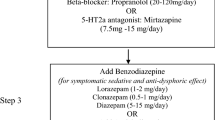Abstract
Antipsychotic-induced akathisia (AIA) is a common and distressing adverse effect associated with many first- and second-generation antipsychotics. The risk of developing AIA can be minimized by administering the minimal effective dosage of an antipsychotic, avoiding rapid dose escalation and avoiding antipsychotic polypharmacy. Once AIA is diagnosed, patients should first receive an adjustment in their antipsychotic drug regimen (i.e. stop antipsychotic polypharmacy if applicable, lower the dosage of the antipsychotic medication or switch to an antipsychotic with lower AIA potential). If further intervention is needed, propranolol is considered as the first-choice anti-akathisia agent. Alternatively, low-dose mirtazapine, anticholinergics and benzodiazepines can also be considered.

Similar content being viewed by others
References
Pringsheim T, Gardner D, Addington D, et al. The assessment and treatment of antipsychotic-induced akathisia. Can J Psychiatry. 2018;63(11):719–29.
Stroup TS, Gray N. Management of common adverse effects of antipsychotic medications. World Psychiatry. 2018;17(3):341–56.
Hohler AD, de Leon MP. Akathisia. In: Kreutzer J, DeLuca J, Caplan B, editors. Encyclopedia of clinical neuropsychology. Cham: Springer; 2007.
Poyurovsky M, Weizman A. Treatment of antipsychotic-induced akathisia: role of serotonin 5-HT2a receptor antagonists. Drugs. 2020;80(9):871–82.
Kumar R, Sachdev PS. Akathisia and second-generation antipsychotic drugs. Curr Opin Psychiatr. 2009;22(3):293–9.
Salem H, Nagpal C, Pigott T, et al. Revisiting antipsychotic-induced akathisia: current issues and prospective challenges. Curr Neuropharmacol. 2017;15(5):789–98.
Berna F, Misdrahi D, Boyer L, et al. Akathisia: prevalence and risk factors in a community-dwelling sample of patients with schizophrenia: results from the FACE-SZ dataset. Schizophr Res. 2015;169(1–3):255–61.
Lima AR, Bacalcthuk J, Barnes TR, et al. Central action beta-blockers versus placebo for neuroleptic-induced acute akathisia. Cochrane Database Syst Rev. 2004(4):CD001946. https://doi.org/10.1002/14651858.CD001946.pub2.
Lima AR, Weiser KV, Bacaltchuk J, et al. Anticholinergics for neuroleptic-induced acute akathisia. Cochrane Database Syst Rev. 2004;(1):CD003727. https://doi.org/10.1002/14651858.CD003727.pub2.
Fleischhacker WW, Roth SD, Kane JM. The pharmacologic treatment of neuroleptic-induced akathisia. J Clin Psychopharmacol. 1990;10(1):12–21.
Rathbone J, Soares-Weiser K. Anticholinergics for neuroleptic-induced acute akathisia. Cochrane Database Syst Rev. 2006(4):CD003727. https://doi.org/10.1002/14651858.CD003727.pub3
Kutcher S, Williamson P, MacKenzie S, et al. Successful clonazepam treatment of neuroleptic-induced akathisia in older adolescents and young adults: a double-blind, placebo-controlled study. J Clin Psychopharmacol. 1989;9(6):403–6.
Pujalte D, Bottai T, Hue B, et al. A double-blind comparison of clonazepam and placebo in the treatment of neuroleptic-induced akathisia. Clin Neuropharmacol. 1994;17(3):236–42.
Fischel T, Hermesh H, Aizenberg D, et al. Cyproheptadine versus propranolol for the treatment of acute neuroleptic-induced akathisia: a comparative double-blind study. J Clin Psychopharmacol. 2001;21(6):612–5.
Stryjer R, Rosenzcwaig S, Bar F, et al. Trazodone for the treatment of neuroleptic-induced acute akathisia: a placebo-controlled, double-blind, crossover study. Clin Neuropharmacol. 2010;33(5):219–22.
Praharaj SK, Kongasseri S, Behere RV, et al. Mirtazapine for antipsychotic-induced acute akathisia: a systematic review and meta-analysis of randomized placebo-controlled trials. Ther Adv Psychopharmacol. 2015;5(5):307–13.
Poyurovsky M, Pashinian A, Weizman R, et al. Low-dose mirtazapine: a new option in the treatment of antipsychotic-induced akathisia. A randomized, double-blind, placebo- and propranolol-controlled trial. Biol Psychiatry. 2006;59(11):1071–7.
Poyurovsky M, Shardorodsky M, Fuchs C, et al. Treatment of neuroleptic-induced akathisia with the 5-HT2 antagonist mianserin. Double-blind, placebo-controlled study. Br J Psychiatry. 1999;174:238–42.
Author information
Authors and Affiliations
Corresponding author
Ethics declarations
Funding
The preparation of this review was not supported by any external funding.
Authorship and conflict of interest
E.S. Kim is a contracted employee of Adis International Ltd/Springer Nature and declares no relevant conflicts of interest. Y.-A. Heo is a salaried employee of Adis International/Springer Nature, is an editor of Drugs & Therapy Perspectives, was not involved in any publishing decision for the manuscript, and declares no relevant conflicts of interest. All authors contributed to the review and are responsible for the article Content.
Ethics approval, Consent to participate, Consent for publication, Availability of data and material, Code availability
Not applicable.
Rights and permissions
About this article
Cite this article
Kim, E.S., Heo, YA. Manage antipsychotic-induced akathisia by making changes to the antipsychotic drug regimen and/or adding anti-akathisia agents. Drugs Ther Perspect 37, 70–74 (2021). https://doi.org/10.1007/s40267-020-00802-1
Published:
Issue Date:
DOI: https://doi.org/10.1007/s40267-020-00802-1




